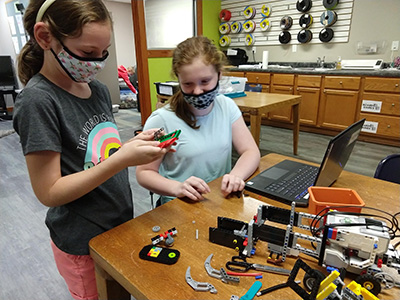Illinois State Library
300 South Second Street
Springfield, IL 62701-1703
United States
The Grants to States Program
The Grants to States Program is the largest grant program run by IMLS; it provides funds to State Library Administrative Agencies (SLAAs) using a population-based formula set by the law. SLAAs determine goals and objectives for the funds in their statutorily required five-year plan (see below). For more information, see the Grants to States program overview.
- Annual Allotments20205619426.0020215594765.0020225632518.0020235805012.0020245736330.00
- 5 Year Plan Text
Each state creates a 5-year plan for its programs to strengthen the efficiency, reach, and effectiveness of library services. View all states' plans.
5 year planAttachment Size illinois5yearplan.pdf 649.63 KB
- 5 Year Evaluation Text
At the end of a 5-year period, each state reports their results in achieving goals and objectives projected in their 5-Year Plan. View all states' evaluations.
5 year evaluationAttachment Size illinois5yearevaluation.pdf 1.65 MB

“The State Library has a long history of assuring grant programs are developed to support and expand library services in over 1,800 public, academic, school, and special library agencies in Illinois. LSTA funds, and even funding from its predecessor LSCA, have played an integral role in assuring library services are available and continue to be relevant to the state’s residents. Three clear priorities continue to be voiced by our libraries 1) investment in resource sharing; 2) continuance of “free” delivery of library materials between the 1,800 library agencies; and 3) investment in the education of the library workforce. Funding from IMLS, coupled with state resources, allows our agency to address these priorities of the Illinois library community.”
-- Greg McCormick, Director, Illinois State Library
Project Examples

Connecting the Digital and Physical Worlds
North Riverside Public Library held three different online workshops for students 10-13 years old, enabling them to connect while quarantined at home due to the COVID pandemic. Sessions covered podcasting, photography, and 3D printing. Participants used technology as a tool to increase self-confidence, patience, and sharpen public speaking skills. The remote learning model required students to be more independent, develop listening skills, and engage in hands-on learning at home. Participants were primarily low-income students who typically do not have access to technology outside the classroom, and the programs helped fill the technology gaps created by remote learning.
IMLS Funds: $12,122

Project Next Generation: Imagine, Innovate, Inspire
During the pandemic, the Brimfield Public Library provided youth in rural Illinois with during- and after-school technology training and career exploration opportunities. With the help of library staff and 22 mentors, a total of 149 individual students ages 10-17 completed one or more projects involving 2D or 3D design, chemistry, circuits, coding, filmmaking, photography, physics, and/or robotics. Grant funds were used to purchase technology and supplies including 3D pens, circuit boards, drones, tablets, and laptops. Students developed their critical thinking and communication skills and learned about the educational and technical requirements for finding work in fields such as archaeology, cinematography, engineering, game design, and photography.
IMLS Funds: $36,190

Radical Fit – Breaking Barriers in Style
Chicago Public Library launched a fashion-based program series through its YOUMedia studio for teens with lead partner Rebirth Garments. They featured fashion-making programs led by amateur and expert designers that introduced skills such as basic sewing, pattern making, and knitting, with a special focus on gender identity and equality. The virtual programs provided tutorials that were made available through the library's YOUMedia YouTube page, in-person fashion workshops, 1200+ Take & Make kits that were distributed to the library's 81 branches across the city, virtual interviews, small group discussions, and a final celebratory fashion event in partnership with the Chicago Park District.
IMLS Funds: $40,000
Review recent Grants to States projects from this state library in the State Program Report database.
Search the Awarded Grants Database for additional details about awards in this state
Five-Year Plan Highlights
Goal 1: Position the Illinois library community to extend library services for all Illinois residents by providing access to information and ideas.
- Projects Include:
- Subgrants and agreements for interlibrary loan and delivery services
- Subgrants for database subscriptions
- Subgrants and agreements for cataloging and digitization
- Subgrants and agreements for research, statistics, and data collection
Goal 2: Position the Illinois library community as an educational anchor by providing opportunities to support education, information fluency and lifelong learning.
- Projects include:
- Subgrant for Talking Book and Braille Services
- Subgrants for continuing education for the library workforce
- Subgrants to provide library-based learning opportunities and for Illinois residents
Goal 3: Position the Illinois library community to provide quality library and information services through innovation in collection development, community engagement, and best practices.
- Projects include:
- Subgrants for libraries to develop innovative collections
- Subgrants for community engagement
- Subgrants to develop best practices and programs that meet the needs of people of diverse backgrounds and abilities
IMLS Data Collection
State Library Administrative Agency Survey
The State Library Administrative Agency Survey (SLAA) provides descriptive data about state library agencies for all fifty states and the District of Columbia. To interact with the latest data, please visit the
SLAA Survey Comparison Tool.
Public Libraries Survey
The Public Libraries Survey (PLS) provides national descriptive data on the status of public libraries in the United States and its territories. Explore state profiles representing more than 9,000 public library systems and over 17,000 public library outlets.

